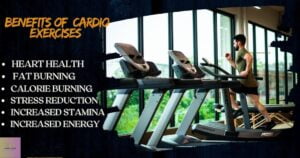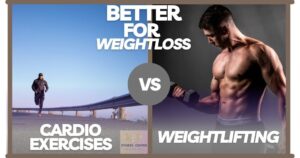Cardio is the melody that gets you moving, while weight-lifting is the harmony that shapes your physique. Cardio and weight-lifting are the dynamic duo of fitness, working together to enhance your overall health, boost energy levels, and unlock your full potential. Cardiovascular exercise fuels your body while weight-lifting strengthens it, creating a powerful synergy that drives your fitness progress.
Cardio and weight-lifting are two sides of the same coin when it comes to fitness. They complement each other and together create a well-rounded and balanced workout routine. Cardio teaches you to push through mental barriers and build stamina while weight-lifting challenges you to push past physical limitations and build resilience.
Cardio is the foundation of cardiovascular health, while weight-lifting is the cornerstone of strength and muscle development. It is very difficult to say which one is better So it’s up to you to choose one of them or both according to your goals. For More
What is the Difference Between Cardio Exercises and Weight-lifting?
Cardiovascular exercise (cardio) and weightlifting are two different types of physical activities that provide distinct benefits and target different aspects of fitness.
Here’s a breakdown of the differences between the two:
Purpose and Main Focus:
CardioExercises: The primary purpose of cardio exercises is to improve cardiovascular health and endurance. It involves activities that elevate your heart rate and increases oxygen consumption, such as running, cycling, swimming, or aerobic classes.
Weightlifting: Weightlifting, also known as strength training or resistance training, focuses on building muscular strength, power, and size. It involves lifting weights, using resistance machines, or performing bodyweight exercises like push-ups, pull-ups, and squats.
Energy Systems:
CardioExercises: Cardio exercises primarily engage the aerobic energy system, which utilizes oxygen to generate energy for prolonged activities. These exercises typically involve moderate intensity and are performed for a more extended duration.
Weightlifting: Weightlifting primarily engages the anaerobic energy system, which relies on stored energy sources, such as ATP and glycogen, to fuel short bursts of high-intensity activity. Weightlifting exercises are characterized by shorter durations and higher intensity.
Benefits
CardioExercises: Cardio exercises primarily target the cardiovascular system, promoting heart and lung health. They can also contribute to some muscle toning and endurance adaptations but have a limited impact on significant muscle growth.
Weightlifting: Weightlifting provides benefits such as increased muscle strength, power, and size, improved bone density, enhanced joint stability, increased metabolism, better body composition, and functional fitness.
Muscular Adaptations:
CardioExercises: Cardio exercises primarily engage the aerobic energy system, which utilizes oxygen to generate energy for prolonged activities. These exercises typically involve moderate intensity and are performed for a more extended duration.
Weightlifting: Weightlifting focuses on developing muscular strength, hypertrophy (muscle growth), and improved muscular endurance. It can help in sculpting and defining specific muscle groups throughout the body.
Training Approach:
CardioExercises: Cardio exercises typically involve continuous or rhythmic movements over an extended period. The intensity can vary, from low to high, depending on the workout goals.
Weightlifting: Weightlifting often involves performing sets and repetitions with specific weights or resistance levels. The intensity is usually high, and rest periods between sets are common for muscle recovery.
Benefits of Cardio for Weight Loss
Cardiovascular exercise, often referred to as cardio, offers numerous benefits for weight loss.
Here are some of the key advantages of Cardio for Weight Loss:
-
- Increased metabolism: Weightlifting helps build and maintain lean muscle mass. Muscles are metabolically active tissues, meaning they burn more calories even at rest. By increasing your muscle mass through weightlifting, you raise your basal metabolic rate (BMR), resulting in more calories burned throughout the day.
- Fat loss and body composition: Regular cardio workouts can boost your metabolic rate, both during and after the exercise session. This means that even after you’ve finished your workout, your body continues to burn calories at an elevated rate, supporting weight loss efforts
- Fat Burning: Cardio exercises primarily rely on stored fat as a fuel source. During prolonged aerobic activities, such as running or cycling, your body taps into its fat reserves to meet the energy demands. This contributes to reducing overall body fat percentage and helps you achieve a leaner physique.
- Appetite Control: Cardio workouts can help regulate appetite and control food cravings. Exercise releases hormones that suppress hunger and make you feel more satisfied. Additionally, the discipline and commitment required for regular cardio exercise can lead to improved dietary choices and portion control, aiding in weight management.
- Heart Health: Cardiovascular exercise strengthens your heart and improves its efficiency. It enhances blood circulation, lowers blood pressure, reduces the risk of heart disease, and improves overall cardiovascular health. Regular cardio can help you maintain a healthy weight and reduce the likelihood of obesity-related health issues.
- Stress Reduction: Cardio exercises are known to release endorphins, which are natural mood elevators. They help reduce stress, anxiety, and depression, which can be triggers for emotional eating or overeating. By managing stress levels, cardio contributes to a healthier mindset and supports weight loss efforts.
- Increased Stamina and Energy: Regular cardio workouts improve your cardiovascular endurance and muscular stamina. This means you’ll have more energy to perform daily activities and engage in other forms of physical exercise, making it easier to maintain an active lifestyle and burn more calories.

Remember that while cardio is beneficial for weight loss, combining it with strength training and a balanced diet will yield the best results. It’s also important to consult with a healthcare professional or certified fitness trainer before starting any new exercise regimen, especially if you have any underlying health conditions.
Benefits of Weight-lifting for Weight Loss

Weightlifting can be an effective tool for weight loss and offers several benefits
Here are some key advantages of weightlifting for weight loss:
-
- Increased metabolism: Weightlifting helps build and maintain lean muscle mass. Muscles are metabolically active tissues, meaning they burn more calories even at rest. By increasing your muscle mass through weightlifting, you raise your basal metabolic rate (BMR), resulting in more calories burned throughout the day.
- Fat loss and body composition: Regular weightlifting workouts can boost your metabolic rate, both during and after the exercise session. This means that even after you’ve finished your workout, your body continues to burn calories at an elevated rate, supporting weight loss efforts.
- Increased calorie expenditure: Weightlifting is a form of resistance training that requires significant energy expenditure. During a weightlifting session, you burn calories not only while lifting weights but also during the recovery process when your body repairs and rebuilds muscles. This increased calorie expenditure contributes to overall weight loss.
- Improved insulin sensitivity: Weightlifting can enhance insulin sensitivity, which is crucial for weight loss and overall health. When your body becomes more sensitive to insulin, it efficiently uses glucose for energy rather than storing it as fat. This can help regulate blood sugar levels and prevent insulin resistance, which is often associated with weight gain and metabolic disorders.
- Enhanced cardiovascular health: While weightlifting is not primarily aerobic exercise, it can still provide cardiovascular benefits. Compound exercises like squats, deadlifts, and bench presses engage multiple muscle groups and elevate heart rate, improving cardiovascular fitness and promoting a healthy heart.
- Strength and functional fitness: Weightlifting improves overall strength and functional fitness, allowing you to perform daily activities with ease and reduce the risk of injuries. With increased strength, you may also be more motivated to engage in other physical activities, leading to additional calorie burning and weight loss.
- Psychological well-being: Regular weightlifting has positive effects on mental health and well-being. Physical activity releases endorphins, which are natural mood enhancers, helping to reduce stress, anxiety, and symptoms of depression.
Weightlifting can boost self-confidence, body image, and overall self-esteem as you witness improvements in strength, muscle tone, and body composition.
Remember that weightlifting should be combined with a balanced diet and other forms of exercise for optimal weight loss results. It’s also important to consult with a healthcare professional or certified trainer before starting any new exercise program, especially if you have underlying health conditions or injuries.
Which Should Come First: Cardio Exercises or Weightlifting?
The order of doing weights before cardio or cardio before weights is a topic of debate among fitness enthusiasts and experts. Ultimately, the decision depends on your specific fitness goals and preferences.
When to do Weightlifting Before Cardio Exercises?
If your main focus is on building strength, muscle mass, or improving power, it is generally recommended to perform weightlifting exercises first. This approach allows you to allocate your energy and focus on heavier, more demanding exercises when you’re fresh.
When to do Cardio Exercises Before Weightlifting?
If your primary goal is to improve cardiovascular endurance or burn calories, doing cardio before weights may be more suitable. Starting with Cardio exercise can elevate your heart rate and warm up your muscles, preparing you for an effective weightlifting session afterward.
It’s important to note that regardless of the order you choose, incorporating proper warm-up exercises, stretching, and cool-down routines is essential for injury prevention and overall fitness. Listening to your body and adjusting your routine based on your energy levels and individual needs is always a good approach.
Calories Burn During 30 Minutes of Cardio Session
The number of calories burned during a 30-minute cardio session can vary depending on several factors, including your weight, age, gender, and the intensity of the exercise. However, I can provide you with estimated calorie burns for different types of cardio exercises based on an average weight of 155 pounds (70 kilograms).
Keep in mind that these numbers are approximate and individual results may vary:
-
- Running: Approximately 295-372 calories burned in 30 minutes, depending on your pace (8-minute mile to 10-minute mile).
-
- Cycling (moderate intensity, 12-14 mph): Around 260-311 calories burned.
-
- Swimming (moderate effort): Roughly 236-295 calories burned.
-
- Jumping rope: Approximately 236-372 calories burned.
-
- Jumping rope: Approximately 236-372 calories burned.
-
- Aerobic dance or Zumba: Around 177-295 calories burned.
-
- Brisk walking (3.5 mph): Roughly 140-186 calories burned.
Calories Burn During 30 Minutes of Weight lifting Session
The number of calories burned during a weightlifting session can vary depending on several factors, including your body weight, the intensity of the workout, the specific exercises performed, and your metabolism. However, I can provide you with a general estimate.
On average, a person weighing around 155 pounds (70 kilograms) can burn approximately 112-223 calories during a 30-minute weightlifting session. For a person weighing 200 pounds (91 kilograms), the calorie burn can range from 145-289 calories. These values are estimates and can vary from person to person.
It’s worth noting that weightlifting primarily builds muscle and strength rather than focusing on calorie burning. However, weightlifting does have additional benefits such as increasing your metabolism and improving body composition by increasing muscle mass.
If your main goal is to burn calories, combining weightlifting with cardiovascular exercises like running, cycling, or swimming can be more effective in achieving higher calorie burn.
Is Cardio Exercises Or Weight Lifting Better for Weight Loss?
Both cardio exercises and weight lifting can contribute to weight loss, but they have different effects on the body and overall health. The best approach depends on your goals, preferences, and individual circumstances.
Cardio exercises, such as running, cycling, swimming, or aerobics, are effective for burning calories and increasing your heart rate. They primarily focus on improving cardiovascular endurance and stamina. Cardio exercises elevate your heart rate and help create a calorie deficit, which can lead to weight loss. They also offer additional benefits such as improving cardiovascular health, increasing lung capacity, and boosting mood.
On the other hand, weight lifting (also known as resistance or strength training) focuses on building muscle strength and mass. While weight lifting may not burn as many calories during the workout as cardio exercises, it can have a lasting impact on your metabolism. By increasing muscle mass, you can raise your basal metabolic rate, which means your body will burn more calories even at rest. Additionally, weight lifting helps preserve existing muscle while losing weight, which is crucial for maintaining healthy body composition.
Conclusion
In terms of weight loss, a combination of both cardio exercises and weight lifting can yield the best results. Incorporating cardio exercises into your routine can help burn calories and improve cardiovascular health, while weight lifting can help build and maintain muscle mass, leading to long-term benefits for weight management.
It’s also important to note that diet plays a significant role in weight loss. Regardless of the type of exercise you choose, a balanced and calorie-controlled diet is essential for achieving sustainable weight loss.
Ultimately, the ideal approach to weight loss is a combination of regular physical activity, including both cardio exercises and weight lifting, along with a healthy diet. It’s recommended to consult with a healthcare professional or a certified fitness trainer to tailor an exercise plan that suits your specific needs and goals.

